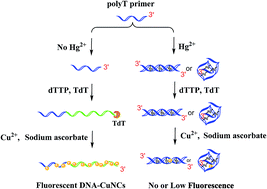DNA-templated copper nanoclusters obtained via TdT isothermal nucleic acid amplification for mercury(ii) assay
Abstract
Herein, DNA-templated copper nanoclusters (CuNCs) synthesized by terminal deoxynucleotidyl transferase (TdT) isothermal nucleic acid amplification (INAA) were proposed for Hg2+ assay. TdT recognized the 3′-OH end of primers and subsequently prolonged the single strand poly-T at 3′-OH with the assistance of deoxythymidine triphosphate (dTTP). The generated products coordinated with the copper ions to form DNA-templated CuNCs, resulting in remarkable fluorescence. The introduction of Hg2+ made the primers form a T–Hg2+–T mismatch duplex, which prevented the capture of the 3′-OH end by TdT. The poly-T single strand prolongation reaction was suspended; this led to fluorescence quenching. Hg2+ could be detected at a concentration as low as 76 pM with a significant linear range from 0.2 to 500 nM. This method, performed in one tube in one step, does not involve washing and separation steps, which provides a novel insight into the ultra-sensitive detection of toxic analytes in water quality applications.



 Please wait while we load your content...
Please wait while we load your content...